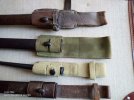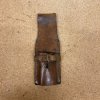-
Welcome to this forum . We are a worldwide group with a common interest in Birmingham and its history. While here, please follow a few simple rules. We ask that you respect other members, thank those who have helped you and please keep your contributions on-topic with the thread.
We do hope you enjoy your visit. BHF Admin Team
You are using an out of date browser. It may not display this or other websites correctly.
You should upgrade or use an alternative browser.
You should upgrade or use an alternative browser.
Home Guard
- Thread starter rocketron
- Start date
Richard Dye
master brummie
All of those blades a quite substantial and am sure very effective!Back to the SMLE this is the 1st patern bayonet issued in 1903
using a Lee Method blade
ie my blade is dated1900 on a 1903 marked BayonetView attachment 204099
mw0njm.
A Brummie Dude
terrable thingsAll of those blades a quite substantial and am sure very effective!
Richard Dye
master brummie
Can imagine, the clearances are large (I understand) but great receptors of dirt and grit as Pete suggests.The Ross proved to have a very poor tolerance of dirt and grit, the screw threads operating the bolt lugs would then jam the weapon open or closed in the heat of battle.
View attachment 204101
Brown leather bayonet frog for the 1907 SMLE and the US P14 bayonet.
Used by Home Guard
View attachment 204105
yes purely HG issueBrown leather bayonet frog for the 1907 SMLE and the US P14 bayonet.
Used by Home Guard
View attachment 204105
it would fit a 07 bayonet scabbard
Button Stud or Teardrop Stud
Regs or Terris had
Patt 1908 Webb Frog
Patt 1914 Leather Frog
Patt 1937 Webb Frog
Photos of mine
coming in a Mo
not forgetting
Patt 1925 RAF Frog
Patt 1944 Frog For No 4/5/7&9 Bayonets & L1A3S Later On
Last edited:
Richard Dye
master brummie
That looks like it is new……Brown leather bayonet frog for the 1907 SMLE and the US P14 bayonet.
Used by Home Guard
View attachment 204105
Richard Dye
master brummie
Ah, thank you!Yes
its a repro
Loads on ebay
mw0njm.
A Brummie Dude
NiceOriginal WW1 British Pattern 1914 Leather equipment bayonet frog.
Stamped on rear
R
1916
OLFSKY & Co
LONDON
View attachment 204119
but its missing strap for entrenching tool
1916 is a late date as they were very short lived
i have another 5 or 6 bayonets with P14 frogs
we on rd trip at mo i check them out when home
Last edited:
Wow ! John Rhodes was my grandfather’s brother- I never knew about this!Another brave Home Guard man, Sgt John Rhodes of Cook Street, Nechells. Viv.
View attachment 166116
Source: British Newspaper Archive



